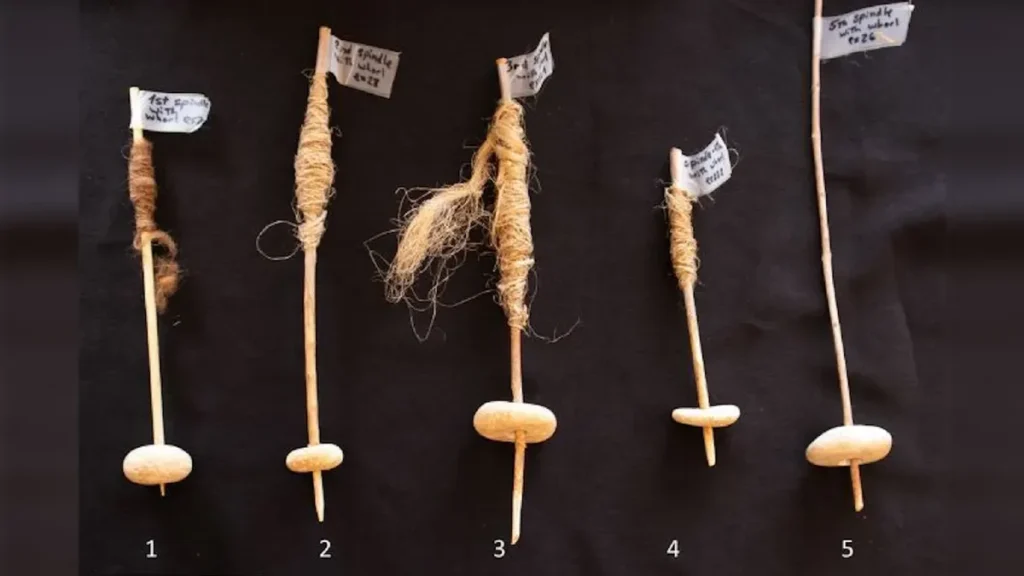The researchers made experimental spindles and whorls based on 3D scans of the pebbles.
Yashuv and Grosman, PLOS ONE, 2024 under CC-BY 4.0
When faced with an assortment of 12,000-year-old perforated pebbles from an archaeological site in northern Israel, researchers wondered if the artifacts could be beads, or perhaps fishing weights. Now, however, they’ve come to a much more significant conclusion: The pebbles could be spindle whorls, weighted pieces used in spinning textiles.
If that interpretation is true, it would make the pebble collection one of the oldest examples of rotational technology, a crucial prerequisite to the invention of the wheel. The team’s findings were published in the journal PLOS ONE on Wednesday.
“While the perforated pebbles were kept mostly at their natural unmodified shape, they represent wheels in form and function: a round object with a hole in the center connected to a rotating axle,” co-author Talia Yashuv, an archaeologist at the Hebrew University of Jerusalem, tells Live Science’s Owen Jarus.
Using highly detailed 3D models of the 113 pebbles, the archaeologists noted that the mostly limestone artifacts were roughly donut shaped. The holes measured three to four centimeters in diameter and had been drilled halfway from each side of the pebbles, though some of the pieces had off-center, partially perforated holes.
The artifacts had previously been unearthed at Nahal Ein Gev II, a roughly 12,000-year-old Late Natufian village close to the Sea of Galilee. Natufian refers to a hunter-gatherer culture that existed in the region of Palestine and southern Syria around 9000 B.C.E. and preceded the transition toward the agricultural practices that mark the Neolithic period.
Because of the pebbles’ irregular shape and weight, Yashuv and her co-author Leore Grosman ruled out the possibilities that they were prehistoric beads or fishing weights. The artifacts were too heavy and odd-looking to be beads, the team concluded, and they were too light and made of the wrong material for use in fishing. Next, they thought of spindle whorls: small, disc-shaped weights with holes that are attached to spindles to make them rotate faster when spinning textiles.
The researchers decided to test their hypothesis in real time. They used the 3D models to create precise replicas of the artifacts and asked a traditional textile expert named Yonit Crystal to test them out. After some practice, Crystal was able to successfully spin flax—and, with a bit more difficulty, spin wool—into yarn using the pebbles as spindle whorls.
Illustrations representing various spinning methods. (a) Manual thigh-spinning; (b) Spindle-and-whorl “supported spinning”; (c) “drop spinning”; (d) the experimental spindles and whorls and 3D scans of the pebbles and their negative perforations. The photographs show Yonit Crystal spinning fibers with replicas of the perforated pebbles.
Yashuv and Grosman, PLOS ONE, 2024 under CC-BY 4.0
“She was really surprised that they worked, because they weren’t perfectly round,” Yashuv tells New Scientist’s Christa Lesté-Lasserre. “But really you just need the perforation to be located at the center of mass, and then it’s balanced and it works.”
Yashuv adds that the spindle whorl interpretation is consistent with their observations: The method of drilling halfway from each side of the pebble allows for better balance and thus more controlled spinning, and the pieces with incomplete and off-center holes could have been discarded as mistakes.
Because the artifacts are “simple limestone pebbles that don’t stick out at first glance,” the researchers were surprised to learn how they were likely used, Yashuv tells the Times of Israel’s Gavriel Fiske.
If the pebbles are confirmed to be among the oldest examples of spindle whorls, it would mean several things. The most striking is that the artifacts would also represent one of the oldest uses of rotational technologies, which might have paved the way for crucial other advancements, such as potters’ wheels and traditional cart wheels in the fourth millennium B.C.E.
Additionally, “it is probable that flax was being spun in small quantities for use in other emerging technologies such as bags and fishing lines, that is to say new methods of storage and subsistence,” Alex Joffe, an archaeologist and historian specialized in the Middle East who was not involved in the study, tells Live Science. In other words, the spindle whorl could have been crucial to advancements beyond the wheel.
However, archaeological records suggest that the technology died out before re-emerging and taking root in the same region thousands of years later.
“They went back to something else, and we don’t see the same tool for another 4,000 years. When it comes back, what’s interesting is that it’s at a site that is very close by,” Yashuv explains to IFLScience’s Benjamin Taub.
Not everyone is convinced by the researchers’ interpretation. Carole Cheval, an archaeologist at Côte d’Azur University in Nice, France, tells New Scientist that the study should have looked for microscopic traces of the friction caused by yarn on the pebbles. And even if the pebbles are spindle whorls, these tools are more similar to a spinning top than to a wheel, she adds.
Ultimately, “the most important aspect of the study is how modern technology allows us to delve deep into touching the fingerprints of the prehistoric craftsman,” the authors say in a statement, “then learn something new about them and their innovativeness, and at the same time, about our modern technology and how we’re linked.”


